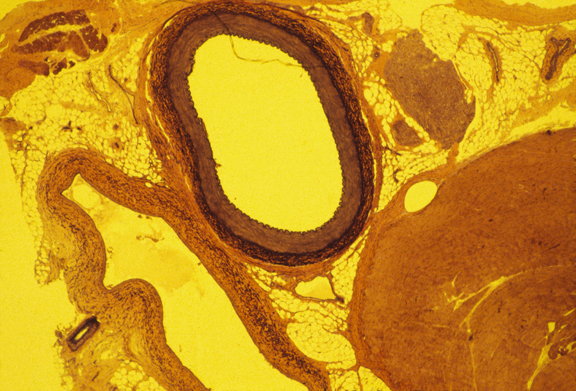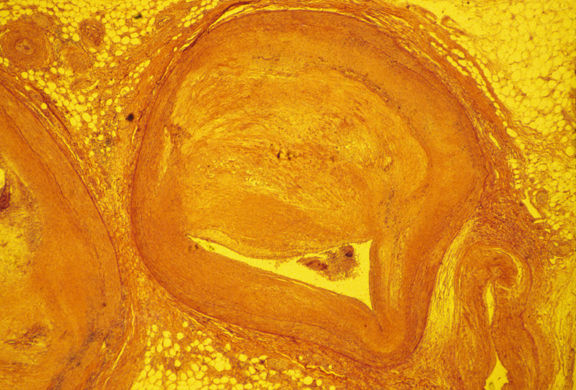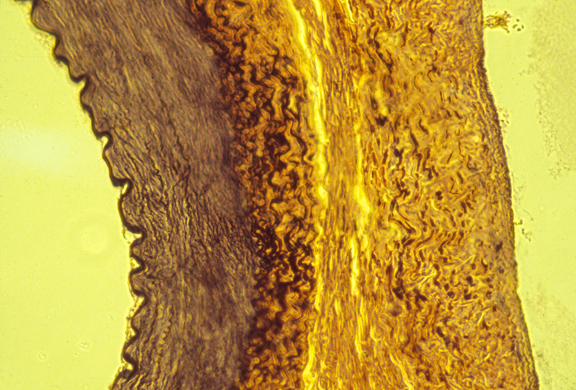Blockage of ArteriesWhich of these two statements is true?1) Blockage of arteries is caused by cholesterol sticking to the inside wall of blood vessels.2) Blockage is caused by thickening of artery walls; macrophages and other white blood cells burrow into the wall and die, which leaves behind masses of cholesterol, attracts more white blood cells, and also stimulates growth and mitotic division of white blood cells.
Arteries have a wall made of smooth muscle lined with an epithelium referred to as endothelial cells. Capillaries are just endothelial cells, without muscles.
Photograph of a cross section showing a normal human artery (top) and vein (lower left).
Atherosclerosis is the blockage of arteries by excess growth of the smooth muscle cells and accumulation of dead cells, macrophages, and cholesterol within the wall. "Atheroma" is the term for the mass of this accumulated material, which at one time was thought to be something like a benign tumor of smooth muscle cells. This is probably not correct. "Plaque" is another name for the same material. Articles on atherosclerosis often say that plaque "builds up" within the arteries. Blood flow is restricted, and eventually the entire artery may be blocked. Note that cholesterol accumulation is within the artery wall, NOT within the lumen.
Photograph of a cross section of atherosclerotic artery.
Macrophages are one of the smallest cell types in the body. When plaque starts forming in an artery, macrophages crawl to that area, probably by chemotaxis. This starts a positive feedback process in which muscle cells are stimulated to multiply by a protein called Platelet-Derived-Growth-Factor, secreted by platelets, which are essential to blood clotting in mammals. (Other vertebrates have thrombocytes instead.)
Wall of an artery (left) and an adjacent vein (right)
Atherosclerosis occurs only in arteries, not in veins. This is thought to be because blood flow in arteries is under much greater pressure than in veins. However, in coronary bypass surgery, a vein from the leg is grafted into a blocked artery, and the grafted vein itself can eventually develop atheromas. There is a very strong correlation between high blood pressure and atherosclerosis.
Fluorescently labeled collagen surrounding an artery.
To summarize, artery blockage is an active process in which white blood cells crawl into the wall of arteries, among the smooth muscle cells of this wall. Blockage is by thickening of the wall itself, and cholesterol is only one of many materials that accumulate in the artery wall. Please don't believe the (extremely prevalent) myth that cholesterol sticks to the inner surface of artery walls, in the way that calcium salts stick to the inner surfaces of metal pipes, and block plumbing. Not only is this myth intuitively plausible, even the NIH web site states it as a fact. (Something that ought to be investigated and challenged, and which is sociologically interesting.) Notice how much better the Wikipedia articles are, as compared with all the other web sites on this topic. Their illustrations are extremely good. http://en.wikipedia.org/wiki/Atheroma Quotes from this Wikipedia article: (Boldface added to focus attention on topics discussed in class, and/or about which exam questions may be asked.) "An atheroma is an accumulation of degenerative material in the tunica intima (inner layer) of artery walls. The material consists of (mostly) macrophage cells, or debris, containing lipids (cholesterol and fatty acids), calcium and a variable amount of fibrous connective tissue. The accumulated material forms a swelling in the artery wall, which may intrude into the channel of the artery, narrowing it and restricting blood flow. Atheroma occurs in atherosclerosis, which is one of the three subtypes of arteriosclerosis (which are atherosclerosis, Monckeberg's arteriosclerosis and arteriolosclerosis)." "In the context of heart or artery matters, atheromata are commonly referred to as atheromatous plaques. It is an unhealthy condition, but is found in most humans." "Veins do not develop atheromata, unless surgically moved to function as an artery, as in bypass surgery. The accumulation (swelling) is always in the tunica intima, between the endothelium lining and the smooth muscle tunica media (middle layer) of the artery wall. [Actually the accumulation is mostly among the smooth muscle cells of the tunica media. AKH] While the early stages, based on gross appearance, have traditionally been termed fatty streaks by pathologists, they are not composed of fat cells, i.e. adipose cells, but of accumulations of white blood cells, especially macrophages, that have taken up oxidized low-density lipoprotein (LDL). After they accumulate large amounts of cytoplasmic membranes (with associated high cholesterol content) they are called foam cells." "In the context of heart or artery matters, atheromata are commonly referred to as atheromatous plaques. It is an unhealthy condition, but is found in most humans." http://en.wikipedia.org/wiki/Atherosclerosis Quotes from this Wikipedia article: "... which an artery wall thickens as a result of invasion and accumulation of white blood cells (WBCs). The accumulation of the WBCs is termed "fatty streaks" early on because of appearance being similar to that of marbled steak. These accumulations contain both living, active WBCs (producing inflammation) and remnants of dead cells, including cholesterol and triglycerides. The remnants eventually include calcium and other crystallized materials, within the outermost and oldest plaque." "The pathobiology of atherosclerotic lesions is very complicated but generally, stable atherosclerotic plaques, which tend to be asymptomatic, are rich in extracellular matrix and smooth muscle cells, while, unstable plaques are rich in macrophages and foam cells and the extracellular matrix separating the lesion from the arterial lumen…" " The atherosclerotic process is not fully understood. Atherosclerosis is initiated by inflammatory processes in the endothelial cells of the vessel wall..." "Endothelial cells respond by attracting monocyte white blood cells, causing them to leave the blood stream, penetrate into the arterial walls and transform into macrophages. The macrophages' ingestion of oxidized LDL particles triggers a cascade of immune responses which over time can produce an atheroma if HDL removal of fats from the macrophages does not keep up. The immune system's specialized white blood cells (macrophages and T-lymphocytes) absorb the oxidized LDL, forming specialized foam cells. If these foam cells are not able to process the oxidized LDL and recruit HDL particles to remove the fats, they grow and eventually rupture, leaving behind cellular membrane remnants, oxidized materials, and fats (including cholesterol) in the artery wall. This attracts more white blood cells, resulting in a snowballing progression." "The relation between dietary fat and atherosclerosis is a controversial field. The USDA, in its food pyramid, promotes a diet of about 64% carbohydrates from total calories. The American Heart Association, the American Diabetes Association and the National Cholesterol Education Program make similar recommendations. In contrast, Prof Walter Willett (Harvard School of Public Health, PI of the second Nurses' Health Study) recommends much higher levels of fat, especially of monounsaturated and polyunsaturated fat. Writing in Science, Gary Taubes detailed that political considerations played into the recommendations of government bodies. These differing views reach a consensus, though, against consumption of trans fats."[link to Taubes article} "The bulk of these lesions is made of excess fat, collagen, and elastin. At first, as the plaques grow, only wall thickening occurs without any narrowing. Stenosis is a late event,…" "...adherence of blood circulating monocytes (a type of white blood cell) to the vascular bed lining, the endothelium, then by their migration to the sub-endothelial space, and further activation into monocyte-derived macrophages. The primary documented driver of this process is oxidized lipoprotein particles within the wall, beneath the endothelial cells." "Calcification forms among vascular smooth muscle cells of the surrounding muscular layer, specifically in the muscle cells adjacent to atheromas and on the surface of atheroma plaques and tissue. In time, as cells die, this leads to extracellular calcium deposits between the muscular wall and outer portion of the atheromatous plaques" "…foam cells and platelets encourage the migration and proliferation of smooth muscle cells, which in turn ingest lipids, become replaced by collagen and transform into foam cells themselves" __________________________________________________________________________________________ http://www.nhlbi.nih.gov/health/health-topics/topics/atherosclerosis QUOTES from a web site of the National Instutes of Health: "Atherosclerosis is a disease in which plaque builds up inside your arteries…" "Plaque is made up of fat, cholesterol, calcium, and other substances found in the blood. Over time, plaque hardens and narrows your arteries." "Coronary heart disease, also called coronary artery disease, is the #1 killer of both men and women in the United States" "Carotid artery disease occurs if plaque builds up in the arteries on each side of your neck (the carotid arteries). These arteries supply oxygen-rich blood to your brain. If blood flow to your brain is reduced or blocked, you may have a stroke." "Peripheral artery disease occurs if plaque builds up in the major arteries that supply oxygen-rich blood to your legs, arms, and pelvis." "If blood flow to these parts of your body is reduced or blocked, you may have numbness, pain, and, sometimes, dangerous infections." "Chronic kidney disease can occur if plaque builds up in the renal arteries. ...causes a slow loss of kidney function" (optional reading) New York Times article from February 2018 on stents used to open blocked arteries |



